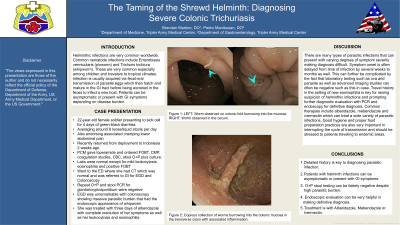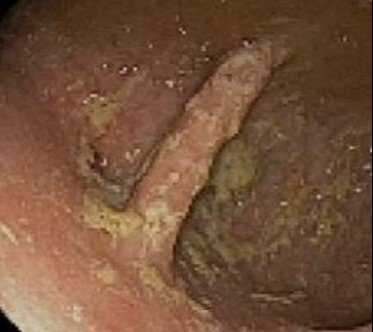Tuesday Poster Session
Category: Colon
P3098 - The Taming of the Shrewd Helminth: Diagnosing Severe Colonic Trichuriasis
Tuesday, October 24, 2023
10:30 AM - 4:00 PM PT
Location: Exhibit Hall

Has Audio
- BM
Brendan Martino, DO
Tripler Army Medical Center
Honolulu, Hawaii
Presenting Author(s)
Brendan Martino, DO, Pedro Manibusan, DO
Tripler Army Medical Center, Honolulu, HI
Introduction: Helminthic infections are very common worldwide. Common nematode infections include Enterobiasis vermicularis (pinworm) and Trichuris trichiura (whipworm). These are very common especially among children and travelers to tropical climates. Infection is usually acquired via fecal-oral transmission of parasite eggs which then hatch and mature in the GI tract before being excreted in the feces to infect a new host. Patients can be asymptomatic or present with GI symptoms depending on disease burden.
Case Description/Methods: 22-year-old otherwise healthy active-duty female presenting with four days of abdominal pain with associated dark diarrhea. She had just returned from a three-week deployment to Indonesia. She went to the ED and diagnosed with gastroenteritis and discharged with Imodium. Computed tomography abdomen/pelvis was unremarkable. Lab work revealed leukocytosis with eosinophilia. Stool culture and ova/parasite testing which were negative. However, FOBT was positive and was referred to GI for endoscopy. Repeat ova/parasite by GI and was negative. Repeat CBC revealed worsening leukocytosis and eosinophilia. EGD was unremarkable. Subsequent colonoscopy revealed copious parasitic worm burden throughout the colon with associated mucosal inflammation. Colon and parasite biopsies were obtained and sent for parasite identification. Given the endoscopic appearance of the parasite, Trichuriasis was suspected, and she was treated with three days of albendazole. She responded well clinically to treatment with resolution of her leukocytosis and eosinophilia.
Discussion: There are many types of parasitic infections that can present with varying degrees of symptom severity making diagnosis difficult. Symptom onset is often delayed from time of infection by several weeks to months as well. This can further be complicated by the fact that laboratory testing such as ova and parasite as well as advanced imaging studies can often be negative such as this in case. Travel history in the setting of new eosinophilia is key for raising suspicion of helminthic infections and prompting further diagnostic evaluation with PCR and endoscopy for definitive diagnosis. Common therapies include albendazole, mebendazole and ivermectin which can treat a wide variety of parasitic infections. Good hygiene and proper food preparation practices are also very important in interrupting the cycle of transmission and should be stressed to patients traveling to endemic areas.

Disclosures:
Brendan Martino, DO, Pedro Manibusan, DO. P3098 - The Taming of the Shrewd Helminth: Diagnosing Severe Colonic Trichuriasis, ACG 2023 Annual Scientific Meeting Abstracts. Vancouver, BC, Canada: American College of Gastroenterology.
Tripler Army Medical Center, Honolulu, HI
Introduction: Helminthic infections are very common worldwide. Common nematode infections include Enterobiasis vermicularis (pinworm) and Trichuris trichiura (whipworm). These are very common especially among children and travelers to tropical climates. Infection is usually acquired via fecal-oral transmission of parasite eggs which then hatch and mature in the GI tract before being excreted in the feces to infect a new host. Patients can be asymptomatic or present with GI symptoms depending on disease burden.
Case Description/Methods: 22-year-old otherwise healthy active-duty female presenting with four days of abdominal pain with associated dark diarrhea. She had just returned from a three-week deployment to Indonesia. She went to the ED and diagnosed with gastroenteritis and discharged with Imodium. Computed tomography abdomen/pelvis was unremarkable. Lab work revealed leukocytosis with eosinophilia. Stool culture and ova/parasite testing which were negative. However, FOBT was positive and was referred to GI for endoscopy. Repeat ova/parasite by GI and was negative. Repeat CBC revealed worsening leukocytosis and eosinophilia. EGD was unremarkable. Subsequent colonoscopy revealed copious parasitic worm burden throughout the colon with associated mucosal inflammation. Colon and parasite biopsies were obtained and sent for parasite identification. Given the endoscopic appearance of the parasite, Trichuriasis was suspected, and she was treated with three days of albendazole. She responded well clinically to treatment with resolution of her leukocytosis and eosinophilia.
Discussion: There are many types of parasitic infections that can present with varying degrees of symptom severity making diagnosis difficult. Symptom onset is often delayed from time of infection by several weeks to months as well. This can further be complicated by the fact that laboratory testing such as ova and parasite as well as advanced imaging studies can often be negative such as this in case. Travel history in the setting of new eosinophilia is key for raising suspicion of helminthic infections and prompting further diagnostic evaluation with PCR and endoscopy for definitive diagnosis. Common therapies include albendazole, mebendazole and ivermectin which can treat a wide variety of parasitic infections. Good hygiene and proper food preparation practices are also very important in interrupting the cycle of transmission and should be stressed to patients traveling to endemic areas.

Figure: Copious collection of worms burrowing into the colonic mucosa in the transverse colon with associated inflammation
Disclosures:
Brendan Martino indicated no relevant financial relationships.
Pedro Manibusan indicated no relevant financial relationships.
Brendan Martino, DO, Pedro Manibusan, DO. P3098 - The Taming of the Shrewd Helminth: Diagnosing Severe Colonic Trichuriasis, ACG 2023 Annual Scientific Meeting Abstracts. Vancouver, BC, Canada: American College of Gastroenterology.
